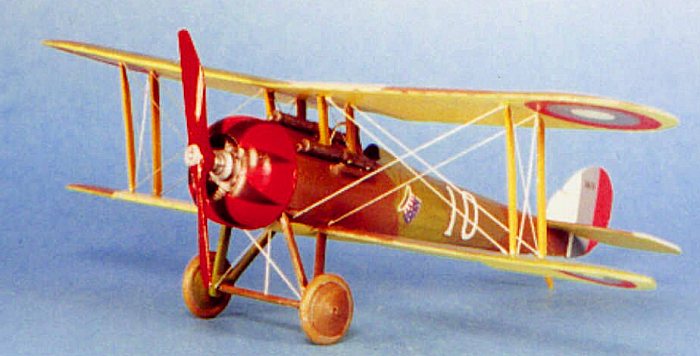
Blue Max 1/48 Nieuport 28
|
KIT # |
106 |
|
PRICE: |
$40.95 |
|
DECALS: |
Two Aircraft: 94th Aero Squadron, Swiss AF |
|
REVIEW BY: |
|
|
NOTES: |
|

AMERICA'S FIRST "ACE-MAKER"
|
HISTORY |
The Nieuport line had been established with the Nieuport 10 as a light-weight, rotary-powered airplane with a sesquiplane layout in which the lower wing is less than half the area of the upper wing. The design was solidified with the Nieuport 11 "Bebe," which appeared in late 1915 and did much to erase the "Fokker Scourge" in early 1916. The Nieuport design became "classic" with the Nieuport 17, the mount of such aces as Guynemer, Nungesser, Ball and Bishop in 1916-17. However, by 1917 it was obvious the design had seen better days, with the Nieuports 23, 24 and 27 being essentially variations on the theme of the Nieuport 17. The heavier and faster SPAD VII and the later XIII paved the way for the fighters of the last year of the Great War.
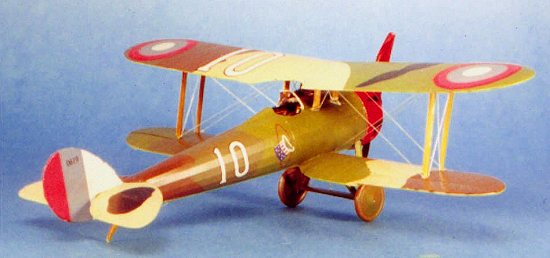 Nieuport answered the SPAD
VII with the Nieuport 28, which maintained the tradition of light weight and
rotary power, but changed to a biplane design with upper and lower wings of
equal area and a hefty increase in speed. Aesthetically, the Nieuport 28 was
among the best-looking fighters of the war, with its gracefully rounded wingtips
and curvaceous tail, mated to a slim cigar-shaped fuselage. Unfortunately, the
design was not as robust as the SPAD series. France had to concentrate its
limited aeronautical and industrial resources, and the French Air Force chose
the SPAD, rejecting the Nieuport in late 1917.
Nieuport answered the SPAD
VII with the Nieuport 28, which maintained the tradition of light weight and
rotary power, but changed to a biplane design with upper and lower wings of
equal area and a hefty increase in speed. Aesthetically, the Nieuport 28 was
among the best-looking fighters of the war, with its gracefully rounded wingtips
and curvaceous tail, mated to a slim cigar-shaped fuselage. Unfortunately, the
design was not as robust as the SPAD series. France had to concentrate its
limited aeronautical and industrial resources, and the French Air Force chose
the SPAD, rejecting the Nieuport in late 1917.
This left Nieuport with the choice of becoming a sub-contractor for SPADs, or trying for a new design (which they did with an unsuccessful design known as the Nightjar). However, there was another customer - the United States - anxious to find a single-seat fighter for its new air force, and experiencing difficulty in obtaining the main fighters of its British and French allies. The United States had entered the war in April 1917 with essentially no air force, and no domestic designs capable of competing successfully with European designs. Nieuport had the production capacity, and the ability to deliver the Nieuport 28 relatively quickly. The deal was struck in early 1918, and the Nieuport 28 became the first single-seat fighter of the U.S. Army Air Service.
The Nieuport was original equipment for the squadrons of the First Pursuit Group, including the 94th "Hat in the Ring" Aero Squadron, and the 103rd Aero Squadron, formerly the Lafayette Escadrille. It would also be original equipment for squadrons of the Second Pursuit Group, though they would not take it into combat, having equipped with the SPAD XIII by the time they went to the front in July 1918. The squadrons of the First Pursuit Group, which received their airplanes beginning in late April 1918 - wich arrived without guns! - were forced to discover the things that had led to the French rejection of the airplane, such as its propensity for shedding the fabric of the upper wing in a prolonged dive. Eddie Rickenbacker experienced this on May 11, 1918, and was able through superior flying ability and luck to bring the badly-damaged airplane back to Toul airdrome, where subsequent investigation was able to finally find the cause of what to then had been mysterious and unexplained crashes.
The First Pursuit Group never liked the Nieuport, though other U.S. units who learned to fly the airplane within its limits did like it and several were actually reluctant to trade it in for the (comparatively) heavy SPAD XIII; it must be remembered, however, that the experience of the First Pursuit Group involved green pilots flying combat against a highly-experienced foe.
Douglas Campbell: America's First Ace:
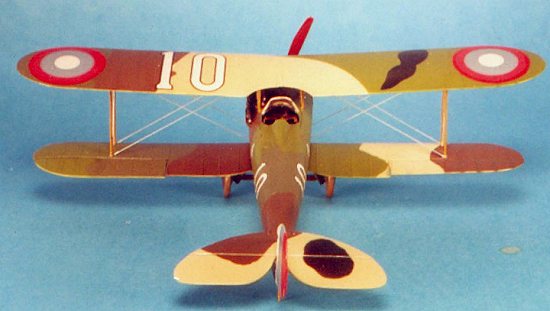 Let's be clear: Douglas
Campbell was not the first American to become an ace pilot in the Great War -
there were several, flying in both the French and British air forces, who
achieved that rank long before. Campbell was the first American in the American
Air Force to achieve this status.
Let's be clear: Douglas
Campbell was not the first American to become an ace pilot in the Great War -
there were several, flying in both the French and British air forces, who
achieved that rank long before. Campbell was the first American in the American
Air Force to achieve this status.
Stuart E. Elliott, in his excellent memoir "Wooden Crates and Gallant Pilots" (highly recommended if you can find it to those who wish to know what the day-to-day experiences of a American pilot in the Great War was like), describes his Harvard classmate as an extremely interesting person. Campbell's father was, in 1917, a famed astronomer and head of the Lick Observatory; he would later become President of the University of California after the war. Campbell had been a member of the Harvard varsity football team "in those now-incredible days when Harvard was actually a terror to most opponents." Campbell dropped out of Harvard upon the U.S. Declaration of War in April 1917, and was among the first of the new officers selected for the U.S. Air Service, along with his great friend Quentin Roosevelt, son of the former President. Both Campbell and Roosevelt were among the Americans who graduated from the first ground school and were then sent directly to France in the summer of 1917 for flying training. Thus, by the time the 94th Aero Squadron was formed in early 1918, Campbell was among the better-trained and more experienced members of the unit.
Campbell and Alan Winslow shared credit for the 94th Aero Squadron's first official victory over an enemy aircraft on May 19, 1918, in which Campbell's gun jammed (the Nieuport at the time was only armed with one instead of two due to supply shortages); he feinted a further attack while clearing the jam, then bored in for the kill. For this, he was awarded the Distinguished Service Cross. Campbell became the first United States Air Service pilot to score five confirmed victories with his victory of June 3, 1918. He scored his sixth and final victory on June 5, when he and James Meissner shot down a Rumpler near Nancy. Campbell was wounded in the back by an explosive bullet and returned to the United States. This was not so much due to the wound as it was the U.S. Army's desire to preserve its first ace long enough to use him back home to help raise Liberty Bonds, thus beginning a tradition of using top-scoring pilots for war bond drives that would extend through World War II and Korea. Many of Campbell's contemporaries believe that - had he remained at the front through the summer and fall of 1918 - it would have been he and not Eddie Rickenbacker who would have been America's Ace of Aces in the Great War.
Douglas Campbell died on December 19, 1990, in Greenwich, Connecticut.
|
THE KIT |
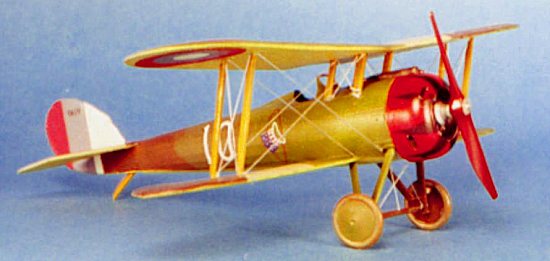 The Nieuport 28 is the
sixth of the 1/48 First World War aircraft model releases from Blue Max. As with
all the others, it is a mixed-media, limited-run kit (only 1,500 kits made),
with wings, tail, fuselage and landing gear in a soft medium-grey plastic, and
such details as the engine, cowling, machine guns, and all cockpit details in
white metal. Decals are provided for Douglas Campbell's "white 10" of
the 94th Aero Squadron, and an all-silver aircraft flown by the Swiss Air Force
in 1918-19.
The Nieuport 28 is the
sixth of the 1/48 First World War aircraft model releases from Blue Max. As with
all the others, it is a mixed-media, limited-run kit (only 1,500 kits made),
with wings, tail, fuselage and landing gear in a soft medium-grey plastic, and
such details as the engine, cowling, machine guns, and all cockpit details in
white metal. Decals are provided for Douglas Campbell's "white 10" of
the 94th Aero Squadron, and an all-silver aircraft flown by the Swiss Air Force
in 1918-19.
As regards detail, the wings do not suffer from the dread "Blue Max wing ripple," and are accurate representations of fabric-covered surfaces: taut and flat, with only the rib tape showing up, rather than the "hills and valleys" so often used. The fuselage continues this, with the rear fuselage - formed by stringers beneath the fabric - being a series of flat facets.
The decals are the least-good of any Blue Max kit, which is surprising inasmuch as decals are generally a strong point in these kits. The red outer rings of the US cockades is not completely opaque, and the white circle that is supposed to be backing for this and the blue ring does not extend completely to the edge of the cockade. This results in a "two color" outer circle, which can be corrected with paint, before or after the decal is applied. There is a registration problem with the famous "hat in the ring" insignia, also.
|
CONSTRUCTION |
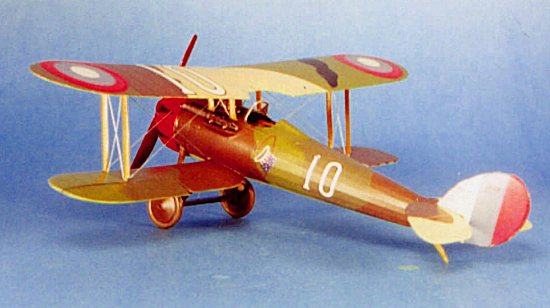 Construction starts with
the cockpit. With any Blue Max kit it is advisable to have the DataFile for that
airplane. A review of the available photos shows that the cockpit detail is not
that accurate. However, it is only visible through a relatively small opening,
which means thatonly the seat, side frame detail, control stick and instrument
panel are visible. The sticklers for accuracy can go to town here if they want;
I chose to modify the instrument panel and the side frames a bit to conform with
the photos, and otherwise installed it as directed. I pre-painted the frame and
the fuselage interior to show the wooden panels used on the forward airframe
with the after area done in clear doped linen, with the frame painted a
yellow-brown to simulate ash. I used Eduard French WW1 photo-etch seatbelts,
since the kit provides none. The fuselage went together and was set aside to dry
after the lower wing was attached and aligned.
Construction starts with
the cockpit. With any Blue Max kit it is advisable to have the DataFile for that
airplane. A review of the available photos shows that the cockpit detail is not
that accurate. However, it is only visible through a relatively small opening,
which means thatonly the seat, side frame detail, control stick and instrument
panel are visible. The sticklers for accuracy can go to town here if they want;
I chose to modify the instrument panel and the side frames a bit to conform with
the photos, and otherwise installed it as directed. I pre-painted the frame and
the fuselage interior to show the wooden panels used on the forward airframe
with the after area done in clear doped linen, with the frame painted a
yellow-brown to simulate ash. I used Eduard French WW1 photo-etch seatbelts,
since the kit provides none. The fuselage went together and was set aside to dry
after the lower wing was attached and aligned.
The white metal engine, with its separate cylinders, is a pain in the patootie, and was replaced with an Aeroclub Gnome le Rhone Monosoupape, which was painted various shades of metal, and shaded with hand-painted Tamiya "Smoke" to bring out detail.
I had already cut away the ailerons from the lower wing and posed them as if "thrown" by the pilot exiting the cockpit. The elevators were also drooped, and the rudder cocked. After I filled the center seam in the fuselage, I attached the tail feathers. The model was now ready for painting.
|
PAINT & DECALS |
Painting:
Bob Pearson has created a CD-ROM of his very excellent World War I aircraft profiles (which will be reviewed here in the near future). Fortunately, he provides a three-view of an unmarked Nieuport 28, which allows one to get the necessary information on the 5-color camouflage pattern. I painted the lower surfaces with Gunze-Sanyo "Radome" to simulate the French color "Ecru" which was used for clear doped linen. The five upper colors were done with Tamiya "Buff," Gunze Sanyo H-302 "Dark Green" and H-340 "Field Green," and Tamiya Red Brown with a bit of Khaki to simulate "Chestnut", and Flat Black with a dash of dark gray to create "Charcoal." I painted the rudder white overall as backing for the decal. The camouflage pattern had hard edges, which I created using drafting tape cut to pattern with thread 1/16" in from the edge to raise it - this prevents the little "ridge" thwt happens when the paint comes up against masking tape that is flat on the surface being painted. The cowling was painted with Gunze Sanyo H-414 "Rot23," which was similar in shade to the red of the decals. When all was dry, I shot the model overall with three light coats of Future.
Decals:
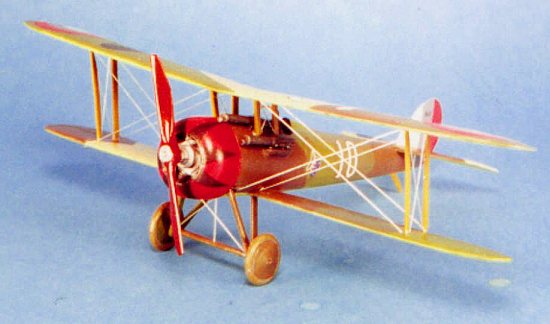 I thought of using the
decals from the Glencoe Nieuport 28, but those roundels suffered from a worse
problem of bleed-through than did the Blue Max decals. I therefore cut circles
from a sheet of white decal, and placed these in position. When they were dry I
applied the kit roundels over them and the bleed-through was solved. The rudder
had bleed-through also, but this was taken care of by having painted the rudder
white. I did use the Glencoe "Hat in the Ring" decals since they were
in register. The "White 10" decals provided in the kit were fine and
were used. When all was set up, I washed the model to get rid of MicroSol
residue, then gave the model another coat of Future. When this was dry, I shot a
single coat of "Flat Future" to dull it down. World War I airplanes
were glossy, but leaving a 1/48 model in a normal glossy finish will be too much
for the scale. The result one wants is more a semi-gloss finish here.
I thought of using the
decals from the Glencoe Nieuport 28, but those roundels suffered from a worse
problem of bleed-through than did the Blue Max decals. I therefore cut circles
from a sheet of white decal, and placed these in position. When they were dry I
applied the kit roundels over them and the bleed-through was solved. The rudder
had bleed-through also, but this was taken care of by having painted the rudder
white. I did use the Glencoe "Hat in the Ring" decals since they were
in register. The "White 10" decals provided in the kit were fine and
were used. When all was set up, I washed the model to get rid of MicroSol
residue, then gave the model another coat of Future. When this was dry, I shot a
single coat of "Flat Future" to dull it down. World War I airplanes
were glossy, but leaving a 1/48 model in a normal glossy finish will be too much
for the scale. The result one wants is more a semi-gloss finish here.
Final Assembly:
I attached the engine and cowling, then the landing gear, wheels and tailskid. The white metal struts next went into their drilled-out positioning holes, fixed in position with cyanoacrylate. The upper wing went on with little difficulty.
The rigging of the Nieuport 28 is relatively simple, and I did it with the High-E guitar string I use for biplane rigging.
|
CONCLUSIONS |
The kit is an excellent representation of the petite aestheticism of the Nieuport 28, with some of the best-done fabric effect of any World War I airplane model. It is far superior to the much less-expensive Glencoe kit, which requires major effort by the modeler to bring that kit to this standard.
Squadron Mail Order has recently discovered a stock of these kits they had mislaid in the warehouse, so though the kit is long out of production, you can obtain one if you act soon.
Copyright ModelingMadness.com. All rights reserved. No reproduction in part or in whole without express permission.
If you would like your product reviewed fairly and fairly quickly, please contact the editor or see other details in the Note to Contributors.
Back to Reviews Page 2024